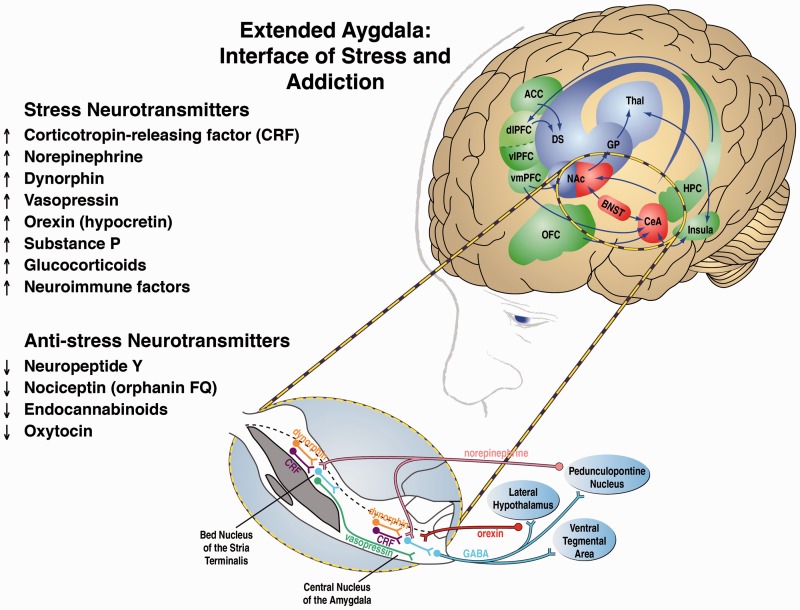Figure 2.
Neural circuitry associated with the three stages of the addiction cycle, with a focus on the withdrawal/negative affect stage and extended amygdala. The targets identified in this review that are relevant to the withdrawal/negative affect stage are listed on the left. On the right is the neurocircuitry of the pathophysiology of addiction. Binge/intoxication stage (blue): Drugs may engage associative mechanisms and reward neurotransmitters (such as dopamine and opioid peptides) in the nucleus accumbens shell and core (incentive salience, defined as a motivational response of the brain to reward-predicting stimuli) and then engage stimulus-response habits that depend on the dorsal striatum. Withdrawal/negative affect stage (red): The negative emotional state of withdrawal engages activation of the extended amygdala. The extended amygdala is composed of several basal forebrain structures, including the bed nucleus of the stria terminalis, central nucleus of the amygdala, and a transition zone in the medial portion (or shell) of the nucleus accumbens. Neurotransmitter systems engaged in the neurocircuitry of the extended amygdala that convey negative emotional states are indicated by upward-pointing arrows, and neurotransmitter systems that may buffer negative emotional states are indicated by downward-pointing arrows. Preoccupation/anticipation (craving) stage (green): This stage involves the prefrontal cortex and includes representations of contingencies, representations of outcomes, and executive function. An important neurotransmitter that is engaged in craving responses is glutamate. The magnified section (blue oval) illustrates the extended amygdala in detail. A major neurotransmitter in the extended amygdala is CRF, which projects to the brainstem where noradrenergic neurons provide a major projection reciprocally to the extended amygdala. Green/blue arrows indicate glutamatergic projections. Acb, nucleus accumbens; ACC, anterior cingulate cortex; BLA, basolateral amygdala; BNST, bed nucleus of the stria terminalis; CeA, central nucleus of the amygdala; CRF, corticotropin-releasing factor; DGP, dorsal globus pallidus; dlPFC, dorsolateral prefrontal cortex; NE, norepinephrine; OFC, orbitofrontal cortex; SNc, substantia nigra pars compacta; VGP, ventral globus pallidus; vlPFC and vmPFC, ventral prefrontal cortex; VTA, ventral tegmental area (modified with permission from Koob and Volkow34; see also Koob33 and Koob and Mason35).

